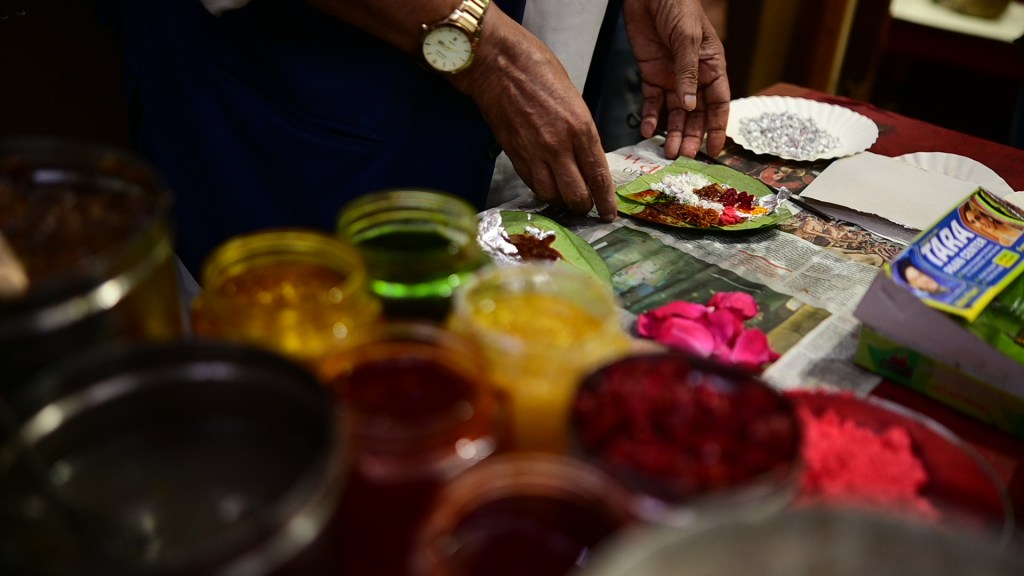On his wedding night in the summer of 1974, the now 74-year-old Mohammad Sarfuddin Siddiqui was gifted a paan by his mother, herself a lover of the fragrant post-meal morsel, wrapped in a betel leaf encasing a variety of ingredients including areca or betel nut, fennel seeds, cloves, and gulkand – a preserve made with rose petals. “I liked the paan a lot, and asked her to make me one more. She told me that if I liked it, and it ‘worked’, then I should start selling it in our shop,” Siddiqui told VICE.
It must have worked well, because not only did the aspiring-actor-turned-paan-maker and businessman start selling the paan in his shop called Tara Pan Centre, but he also decided to name it after one of the most valued diamonds in the world: the Kohinoor. Today, the Kohinoor Paan, priced at a whopping Rs 5,000 ($63), is the legacy of the 55-year-old paan shop in New Usmanpura in the city of Aurangabad in Maharashtra, India.
Videos by VICE

The paan Siddiqui was gifted was made following a prized recipe handed down generations to his mother, who hails from a line of hakeems, or practitioners of herbal medicine. It offered more than just the twin promise of great taste and improved digestion, and was a favourite among royalty, claimed Siddiqui.
Considered a digestive aid and stimulant, paan – a term that refers both to the preparation made with the betel leaf and the leaf itself – has endured India’s long and continually evolving culinary history. Typically served on auspicious occasions including weddings, it can be bought for as little as Rs 10 (13 cents) at any of the tiny paan shops or tobacconists that dot Indian cities and towns. Commanding its fair share of epicureans in the country, preparing the gilauri – the assembling and folding of the betel leaf – is considered an art in itself, one that is honed with experience and skill.

The Kohinoor Paan, Siddiqui told VICE over a phone call, offers “benefits.” “Isse timing badh jata hai (With this, one can last longer),” he said, lowering his voice to mask his likely discomfort. He added that the gold-leaf covered Kohinoor Paan that is decorated with gold vark, or finely pounded edible gold leaf, is stuffed with 12 ingredients, and claimed that its aphrodisiac effects can last up to two days. Of the 12 “exotic,” “very expensive,” and select ingredients that go into the Kohinoor Paan, Siddiqui shared six: saffron, ambar (a type of resin), honey, Kasturi (deer-musk extract), gulkand, and agar – a fragrance found exclusively in east India’s Assam that costs, Siddiqui said, Rs 3,000,000 ($37,755) per kilo – all legally sourced.

The paan is sold as a pair – the “male paan” that has honey, ambar, agar, and edible gold leaf, and the “female paan” with gulkand, sweet paan masala, and “an even sweeter fragrance.” The ingredients that include jari booti or special herbs believed to boost endurance and enhance sexual pleasure, were chosen based on Siddiqui’s mother’s knowledge of Ayurveda, a form of alternative medicine that focuses on holistic healing.
However, Siddiqui sells the paan – one of the 50 varieties available in his shop – with a stern warning: It’s for married heterosexual couples only. In high demand during the Indian wedding season that typically runs from November to February, the paan is presented in a box with three compartments: one for each paan and the third for a small bottle of attar, or perfume “meant to elevate the experience of the paan, because people who are true paan enthusiasts enjoy fragrance a lot.”

How does he determine whether those buying the Kohinoor Paan are really married or not? “We generally get to know when the order is from a wedding ceremony. Moreover, people usually spend this much [only] during weddings. Otherwise, we try to ask people not to buy it unjustly. If someone lies and buys it, then there’s no remedy for that. Rest is all up to trust.”
Does Siddiqui ever worry that his claim that the Kohinoor Paan guarantees an epic love-making session might be a tall one? “The paan is made of Ayurvedic ingredients, and doesn’t have any side-effects. Even if it doesn’t benefit someone, it won’t harm them. We’ve been selling the paan for over 55 years and have heard only good feedback from our customers, who keep coming back for it for a wedding in the family or their own anniversary.”
A 28-year-old businessman and one of Siddiqui’s loyal customers, who preferred to remain anonymous, spoke to VICE over the phone on his way back after buying a Kohinoor Paan. “Everybody has a lot of stress and tension in their daily lives, which impacts our sexual lives as well,” he said. “After having this paan, I’ve experienced the difference in pleasure. My wife insists that I buy it at least once a month. She and I are both very satisfied with it, if you know what I mean.”
Yes, sir, we do know exactly what you mean.
More
From VICE
-

Screenshot: WWE -

Screenshot: Bandai Namco Entertainment Inc. -

-

Screenshot: Shaun Cichacki


